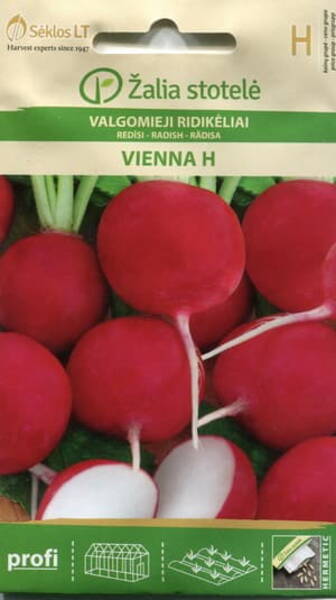An early, large-fruited hybrid (about 5 cm in diameter), resistant to major radish diseases. It is grown without problems both in the spring and in the summer-autumn periods.
Agrotechnics.
For sowing radishes, a site is chosen that emerges early from under the snow, with light, highly fertile soil. The predecessors of radishes can be any vegetable crops, except for the cruciferous family.
Before sowing, fertilizers are applied to the soil. Radishes are sown at several times: at the end of April (the bed is covered with a film before germination), then sowing is carried out at intervals of 2-2.5 weeks, for winter storage, late-ripening varieties are sown in early August.
Seeds are sown in rows with a row spacing of 10-12 cm and a distance between seeds of 2-3 cm to a depth of 1-1.5 cm.
After the emergence of shoots, it is necessary to regularly loosen the soil and keep it moist.
At the height of summer, with the longest daylight hours, planting radishes is recommended to be shaded.
To obtain an earlier and later harvest, radishes are grown in protected ground (in spring, seeds are sown in early March, and in autumn - in early September).
1,0 g = 70-130 seeds.



Raphanus sativus L.
* Many gardeners face the issue of their radishes bolting and flowering during growth - as a result, no standard roots are formed.
There are many reasons for this: small, old seeds, severely overcrowded plantings, dry soil. Prolonged exposure of radishes to low temperatures leads to plant bolting, and the roots become tough and inedible.
This plant should be grown in open, sunny locations; in the shade, the tops become very leggy and the roots grow very small and of poor quality.
Radish is a short-day plant, so it should be sown as early as possible in spring, while the days are still not too long, and in late summer (August), when the days become shorter again.
The root system of radish is underdeveloped, so it should be watered every 2-3 days, and in dry weather - every day (5-8 liters of water per 1 m2).












